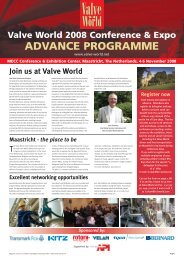Nickel-Aluminium Bronze for Seawater: Flattered by ... - Valve World
Nickel-Aluminium Bronze for Seawater: Flattered by ... - Valve World
Nickel-Aluminium Bronze for Seawater: Flattered by ... - Valve World
You also want an ePaper? Increase the reach of your titles
YUMPU automatically turns print PDFs into web optimized ePapers that Google loves.
4 Corrosion comparison<br />
Corrosion is a complex topic with many variables, including the precise chemical constituents of<br />
the metal concerned, its microstructure and its heat treatment. This is further complicated <strong>by</strong> the<br />
infinite variety of service conditions. The medium itself is only one element, the environment,<br />
pressure, temperature and flow-rate are others that can have a significant effect. Even limiting<br />
consideration to seawater is not straight<strong>for</strong>ward; this varies geographically and is also affected <strong>by</strong><br />
biological activity. The large oil companies invest significantly in metallurgy and corrosion control –<br />
it is interesting to observe the effect of company culture on metallurgical decisions: there is a line in<br />
the North Sea, to the left of which bronze is suitable <strong>for</strong> hydrants, but to the right only titanium will<br />
do! This shows that there are many solutions to similar problems.<br />
What follows is a broad generalisation and is intended to be helpful as an overview. It is drawn<br />
from a variety of sources listed in the bibliography (Appendix IV). It is frustrating that although<br />
much has been written and researched on comparative corrosion, it is inevitable that the<br />
comparison you are searching <strong>for</strong> is not available directly. A certain degree of extrapolation is<br />
necessary. Inevitably the conditions compared are different – often it is difficult to tell if this is<br />
significant or not. While the details given in the following paragraphs are believed to be generally<br />
correct, the specific details in any particular situation should always be considered.<br />
4.1 General corrosion<br />
Most of the materials considered do not have a problem with general corrosion – except <strong>for</strong> carbon<br />
steel and cast iron where protection in the <strong>for</strong>m of coating is required.<br />
4.2 Pitting & crevice corrosion<br />
Pitting is a localised <strong>for</strong>m of attack in quiet seawater, resulting from non-uni<strong>for</strong>mities in the<br />
environment. This is a significant differentiating factor between the materials considered, affecting<br />
stainless and duplexes but not NAB. For materials that are affected, there are tests that give a<br />
critical pitting temperature (CPT) and there is a calculation to assess the resistance to chloride<br />
pitting and crevice corrosion <strong>for</strong> stainless steels (the pitting resistance equivalent number, PREN=<br />
%Cr +3.3x%Mo + {16 or 30}x%N, indicates susceptibility to pitting). These tools give an indication<br />
of pit initiation, rather than pit propagation. Worst affected are the steels and as the alloys become<br />
“higher” the problem disappears. It is worth noting that pit propagation on duplexes can be more<br />
severe than on austenitic materials, and that pitting and crevice corrosion resistance of 22Cr<br />
duplex in waters containing high levels of chloride is poor. Precautions are advised <strong>for</strong> duplexes to<br />
avoid pitting, including coating and cathodic protection as well as removal of oxygen. (Smith,<br />
Celant & Pourbaix, 2000; HSE Safety Notice 7/2007, Norsok M-001).<br />
NAB is not considered to be affected <strong>by</strong> chloride pitting, attack in crevices is minimal and does not<br />
produce pitting or serious roughing of the surface. It is also reported to show no tendency to<br />
chloride stress corrosion cracking. (Oldfield and Masters, 1996; Horwath, 2002)<br />
4.3 Velocity effects<br />
The types of corrosion covered here are erosion-corrosion, cavitation and impingement at higher<br />
velocities and fouling from marine organisms at low or zero flows.<br />
Fouling occurs when marine organisms attach themselves to the material. Due to differential<br />
aeration effects, this sets up a corrosion cell. Copper alloys have an excellent fouling resistance<br />
due to the <strong>for</strong>mation of a film of cuprous oxide corrosion product on the surface which is<br />
inhospitable to marine organisms (Efird, 1975). Ni-Cu has some fouling resistance and the









